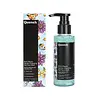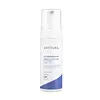What's inside
What's inside
 Key Ingredients
Key Ingredients

 Benefits
Benefits

 Concerns
Concerns

 Ingredients Side-by-side
Ingredients Side-by-side

Water
Skin ConditioningDisodium Laureth Sulfosuccinate
CleansingLauryl Betaine
CleansingCoco-Glucoside
CleansingAcrylates Copolymer
Disodium Cocoamphodiacetate
CleansingSodium Chloride
MaskingPotassium Benzoate
PreservativeTromethamine
BufferingMannitol
HumectantHexylene Glycol
EmulsifyingParfum
MaskingMicrocrystalline Cellulose
AbsorbentSucrose
HumectantDisodium EDTA
Zea Mays Starch
AbsorbentHydroxypropyl Methylcellulose
Emulsion StabilisingButylene Glycol
HumectantEthylhexylglycerin
Skin ConditioningChamomilla Recutita Flower Extract
MaskingBetula Alba Juice
AstringentHippophae Rhamnoides Fruit Extract
Skin Conditioning1,2-Hexanediol
Skin ConditioningCamellia Sinensis Leaf Extract
AntimicrobialTocopherol
AntioxidantPassiflora Incarnata Flower Extract
Skin ConditioningCI 42090
Cosmetic ColorantWater, Disodium Laureth Sulfosuccinate, Lauryl Betaine, Coco-Glucoside, Acrylates Copolymer, Disodium Cocoamphodiacetate, Sodium Chloride, Potassium Benzoate, Tromethamine, Mannitol, Hexylene Glycol, Parfum, Microcrystalline Cellulose, Sucrose, Disodium EDTA, Zea Mays Starch, Hydroxypropyl Methylcellulose, Butylene Glycol, Ethylhexylglycerin, Chamomilla Recutita Flower Extract, Betula Alba Juice, Hippophae Rhamnoides Fruit Extract, 1,2-Hexanediol, Camellia Sinensis Leaf Extract, Tocopherol, Passiflora Incarnata Flower Extract, CI 42090
Water
Skin ConditioningGlycerin
HumectantSorbitol
HumectantPropanediol
SolventCoco-Glucoside
CleansingCaprylyl/Capryl Glucoside
CleansingDisodium Cocoamphodiacetate
CleansingDisodium Cocoyl Glutamate
CleansingSodium Chloride
MaskingCitric Acid
BufferingGlyceryl Caprylate
EmollientDisodium EDTA
Ethylhexylglycerin
Skin ConditioningButylene Glycol
HumectantTocopherol
AntioxidantCamellia Sinensis Leaf Extract
Antimicrobial
 Reviews
Reviews

Ingredients Explained
These ingredients are found in both products.
Ingredients higher up in an ingredient list are typically present in a larger amount.
Butylene Glycol (or BG) is used within cosmetic products for a few different reasons:
Overall, Butylene Glycol is a safe and well-rounded ingredient that works well with other ingredients.
Though this ingredient works well with most skin types, some people with sensitive skin may experience a reaction such as allergic rashes, closed comedones, or itchiness.
Learn more about Butylene GlycolCamellia Sinensis Leaf Extract is derived from the leaves of the tea plant. Black tea, green tea, and oolong tea are all harvested from this plant.
This ingredient has many skin benefits:
This ingredient contains polyphenols, a strong antioxidant. Antioxidants help fight off molecules that damage skin cells.
On top of that, the antioxidants in green tea neutralize free-radicals from the sun. This gives the skin some extra UV protection, but should not replace sunscreen.
Many components of tea have anti-inflammatory properties.
Polyphenols and L-theanine help soothe the skin and reduce irritation. The caffeine in Camellia Sinensis Leaf Extract helps calm inflamed blood vessels.
Other compounds found in tea include: Vitamin Bs, linoleic acid, magnesium, calcium, iron, and zinc.
Research has shown both drinking Camellia Sinensis Leaf Tea and applying it to the skin can help boost skin elasticity and hydration. Studies also show using tea extract may reduce sebum, or oil, production.
Learn more about Camellia Sinensis Leaf ExtractCoco-Glucoside is a surfactant, or a cleansing ingredient. It is made from glucose and coconut oil.
Surfactants help gather dirt, oil, and other pollutants from your skin to be rinsed away.
This ingredient is considered gentle and non-comedogenic. However, it may still be irritating for some.
Learn more about Coco-GlucosideDisodium Cocoamphodiacetate is a surfactant and helps cleanse skin. It is created from the fatty acids of coconut oil.
Surfactants help rinse oil, dirt, and other pollutants easily from skin. It has a faint fruit-like scent.
Disodium EDTA plays a role in making products more stable by aiding other preservatives.
It is a chelating agent, meaning it neutralizes metal ions that may be found in a product.
Disodium EDTA is a salt of edetic acid and is found to be safe in cosmetic ingredients.
Learn more about Disodium EDTAEthylhexylglycerin (we can't pronounce this either) is commonly used as a preservative and skin softener. It is derived from glyceryl.
You might see Ethylhexylglycerin often paired with other preservatives such as phenoxyethanol. Ethylhexylglycerin has been found to increase the effectiveness of these other preservatives.
Chances are, you eat sodium chloride every day. Sodium Chloride is also known as table salt.
This ingredient has many purposes in skincare: thickener, emulsifier, and exfoliator.
You'll most likely find this ingredient in cleansers where it is used to create a gel-like texture. As an emulsifier, it also prevents ingredients from separating.
There is much debate on whether this ingredient is comedogenic. The short answer - comedogenic ratings don't tell the whole story. Learn more about comegodenic ratings here.
The concensus about this ingredient causing acne seems to be divided. Research is needed to understand if this ingredient does cause acne.
Scrubs may use salt as the primary exfoliating ingredient.
Learn more about Sodium ChlorideTocopherol (also known as Vitamin E) is a common antioxidant used to help protect the skin from free-radicals and strengthen the skin barrier. It's also fat soluble - this means our skin is great at absorbing it.
Vitamin E also helps keep your natural skin lipids healthy. Your lipid skin barrier naturally consists of lipids, ceramides, and fatty acids. Vitamin E offers extra protection for your skin’s lipid barrier, keeping your skin healthy and nourished.
Another benefit is a bit of UV protection. Vitamin E helps reduce the damage caused by UVB rays. (It should not replace your sunscreen). Combining it with Vitamin C can decrease sunburned cells and hyperpigmentation after UV exposure.
You might have noticed Vitamin E + C often paired together. This is because it is great at stabilizing Vitamin C. Using the two together helps increase the effectiveness of both ingredients.
There are often claims that Vitamin E can reduce/prevent scarring, but these claims haven't been confirmed by scientific research.
Learn more about TocopherolWater. It's the most common cosmetic ingredient of all. You'll usually see it at the top of ingredient lists, meaning that it makes up the largest part of the product.
So why is it so popular? Water most often acts as a solvent - this means that it helps dissolve other ingredients into the formulation.
You'll also recognize water as that liquid we all need to stay alive. If you see this, drink a glass of water. Stay hydrated!
Learn more about Water